I am facing a problem taking screenshots from Java on Linux with transparent windows.
The problem is that the screenshot taken with Robot deals with transparent windows as if they were opaque.
It is very similar to the problem stated at: Taking a screenshot in Java on Linux?
I wonder if there is any satisfactory solution to avoid this problem.
This is the code I use to take the screenshots:
protected BufferedImage getScreenShot()
{
BufferedImage screenShotImage = null;
try
{
screenShotImage = new Robot().createScreenCapture(new Rectangle(Toolkit.getDefaultToolkit().getScreenSize()));
}
catch( Exception ex )
{
ex.printStackTrace();
}
return( screenShotImage );
}
The code to get the screenshot is the following (at the derived JFrame class):
public void M_repaint( )
{
long timeStamp = System.currentTimeMillis();
if( ( timeStamp - _lastScreenShotTimeStamp ) > 4000 )
{
updateAlpha( 0.0f );
SwingUtilities.invokeLater( new Runnable(){
@Override
public void run()
{
BufferedImage image = getScreenShot();
try
{
ImageIO.write(image, "png", new File( "robotScreenshotBefore.png"));
}
catch( Exception ex )
{
ex.printStackTrace();
}
try
{
String[] cmd = { "./lens.screenshot.sh" };
Process script_exec = Runtime.getRuntime().exec(cmd);
script_exec.waitFor();
}
catch( Exception ex )
{
ex.printStackTrace();
}
image = getScreenShot();
try
{
ImageIO.write(image, "png", new File( "robotScreenshotAfter.png"));
}
catch( Exception ex )
{
ex.printStackTrace();
}
_lensJPanel.setScreenShotImage( image );
updateAlpha( 1.0f );
}
});
_lastScreenShotTimeStamp = timeStamp;
}
repaint();
}
The script ./lens.screenshot.sh has the following contents:
#/bin/bash
rm gnome-screenshot.png
gnome-screenshot --file="gnome-screenshot.png"
The application is a magnifying lens.
The way the application works is that every time the window (the lens) changes its position on the screen, the function M_repaint( ) is called.
Inside that function there is a kind of timer, that makes that when 4 seconds have elapsed from last screenshot, a new screenshot is taken in case the window appearence has changed
Previously to take the screenshot, the JFrame in made invisible, so that it does not appear inside the screenshot itself.
But once the window has been painted on the screen, it appears in the screenshot even if it had been made invisible previously.
I attach one of the sets of screenshots taken from the application with the previus code ( robotScreenshotBefore.png, gnome-screenshot.png and robotScreenshotAfter.png)


